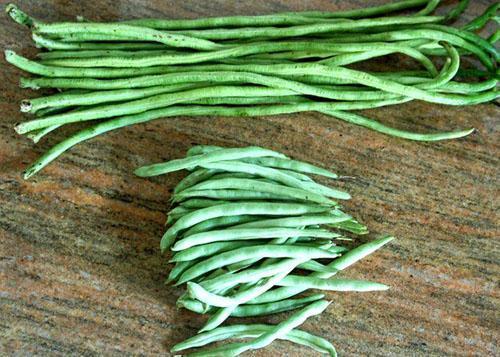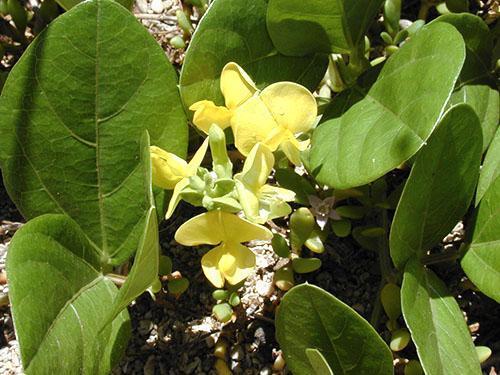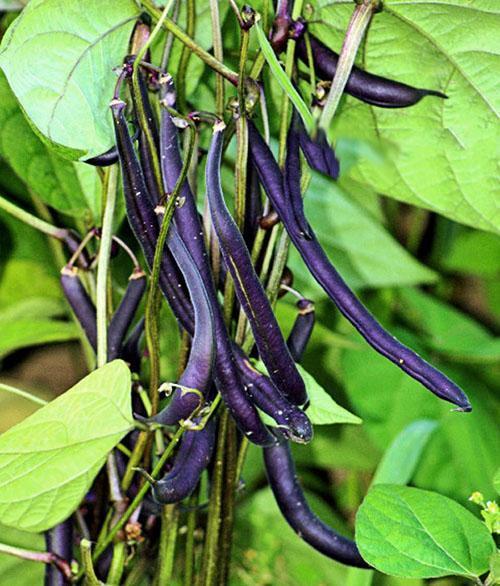We grow asparagus beans on our site
 Asparagus (or green beans) beans are a type of bean whose pods do not contain tough fibers and an inner "parchment" layer. Such beans are used in cooking in the form of whole pods along with the shutters. The ripened grain of such beans is also eaten, although its grains are smaller and harder than those of ordinary beans, so they require additional soaking and boiling.
Asparagus (or green beans) beans are a type of bean whose pods do not contain tough fibers and an inner "parchment" layer. Such beans are used in cooking in the form of whole pods along with the shutters. The ripened grain of such beans is also eaten, although its grains are smaller and harder than those of ordinary beans, so they require additional soaking and boiling.
Biological features

Wign and asparagus are not the same thing. Vigna is a variety of asparagus beans. Asparagus can also include varieties of common beans that do not have fibers and a hard layer in the pod.
The plant is cultivated in three forms:
- bush - 30-50 cm;
- semi-curling - up to two meters;
- curly - from two to five meters.
 The pods come in many different shades - green, yellow, red, dark purple. The pods are rather narrow, growing in length from 12 to 120 cm. The flowers of asparagus beans also differ in a variety of shades, and this plant is often used for decorative purposes. Many varieties are shade tolerant and can be grown in the lace shade of taller plants and even on the north side of houses.
The pods come in many different shades - green, yellow, red, dark purple. The pods are rather narrow, growing in length from 12 to 120 cm. The flowers of asparagus beans also differ in a variety of shades, and this plant is often used for decorative purposes. Many varieties are shade tolerant and can be grown in the lace shade of taller plants and even on the north side of houses.
Asparagus beans - growing and care
 Growing and caring for beans isn't particularly cumbersome. You just need to remember about some of the features of this plant. All varieties of beans are thermophilic. Beans, especially young beans, cannot stand the slightest frost and even cold snaps. At temperatures below 10˚C, beans stop growing, and at negative temperatures they die. However, it is grown almost everywhere. In colder regions, it is sown later, when recurrent frosts have passed. In the northern area, beans are grown through seedlings. In the south, on the contrary, you can manage to grow two, and sometimes even three harvests per season.
Growing and caring for beans isn't particularly cumbersome. You just need to remember about some of the features of this plant. All varieties of beans are thermophilic. Beans, especially young beans, cannot stand the slightest frost and even cold snaps. At temperatures below 10˚C, beans stop growing, and at negative temperatures they die. However, it is grown almost everywhere. In colder regions, it is sown later, when recurrent frosts have passed. In the northern area, beans are grown through seedlings. In the south, on the contrary, you can manage to grow two, and sometimes even three harvests per season.
Beans grow well on loose, drained, organic-rich soils. Its roots stretch over a meter in length, so beans are considered a fairly drought-resistant crop. However, with prolonged drought, plants need watering... Beans cannot stand waterlogging.
Beans grow best in the same area, as their roots enrich the soil with nitrogen. Therefore, when changing the place of cultivation, it is best to take a little land from last year's garden for a new bed. Other good precursors to beans are cabbage, cucumbers, and potatoes.
 The seeds can be sown dry, or they can be soaked in water for a day with the addition of growth stimulants. Honey can be used as growth stimulants, ash, organic humus, slurry. The stimulant drug is prepared in the form of a 1-2% aqueous solution. Spread a layer of gauze on a flat plate, put the seeds on it, cover with a second layer of gauze on top and pour the seeds with a solution so that the gauze is completely moistened.In soaked seeds, the growth processes begin faster and more actively, they give earlier and stronger shoots.
The seeds can be sown dry, or they can be soaked in water for a day with the addition of growth stimulants. Honey can be used as growth stimulants, ash, organic humus, slurry. The stimulant drug is prepared in the form of a 1-2% aqueous solution. Spread a layer of gauze on a flat plate, put the seeds on it, cover with a second layer of gauze on top and pour the seeds with a solution so that the gauze is completely moistened.In soaked seeds, the growth processes begin faster and more actively, they give earlier and stronger shoots.
 It is necessary to sow beans seeds to a depth of 3-4 cm. A very deep planting of seeds leads to a delay in germination and weakening of plants, a shallow one will lead to weakening of the roots. On light sandy soils, bean seeds can be buried a little deeper. It is better to lower two grains into the hole. When sowing beans on ridges, the sowing nests should be placed at a distance of 20-30 cm from each other, leaving 40-50 cm between the rows. With this arrangement, the plants will be provided with the necessary nutritional zone and lighting. Seedlings appear in 5-10 days.
It is necessary to sow beans seeds to a depth of 3-4 cm. A very deep planting of seeds leads to a delay in germination and weakening of plants, a shallow one will lead to weakening of the roots. On light sandy soils, bean seeds can be buried a little deeper. It is better to lower two grains into the hole. When sowing beans on ridges, the sowing nests should be placed at a distance of 20-30 cm from each other, leaving 40-50 cm between the rows. With this arrangement, the plants will be provided with the necessary nutritional zone and lighting. Seedlings appear in 5-10 days.
If there is a threat of night frost, the seedlings must be covered with a film or non-woven material. In the afternoon, the shelter must be removed.
After 3-4 weeks after germination, fertilizing with nitrogen fertilizer can be carried out. This is especially important in dry weather, because in the heat, plants cannot absorb nitrogen from the air in sufficient quantities. If the soil contains little organic fertilizers, then complex fertilizing should be done. When setting fruit, you can feed the beans with a potassium-phosphorus composition. Foliar feeding can also be done. For this purpose, ordinary wood ash is suitable.
 Sow beans, best along the edges of the plot, in a row, directing curly and semi-curling varieties to strong trellises. It is better to make trellises made of wood, since beans do not have a mustache and will be much more difficult for them to wrap around metal or plastic. You can also put curly beans on fences, poles. You can make a "hut" - four poles dug into the ground at the corners of a square with a side of 50-100 cm, and connected by tops. The sides of the "hut" can be reinforced with transverse bars. Bean seeds are sown on the four sides of the "hut" and as it grows, the stems twine around the support, completely hiding it under the mass of foliage and fruits.
Sow beans, best along the edges of the plot, in a row, directing curly and semi-curling varieties to strong trellises. It is better to make trellises made of wood, since beans do not have a mustache and will be much more difficult for them to wrap around metal or plastic. You can also put curly beans on fences, poles. You can make a "hut" - four poles dug into the ground at the corners of a square with a side of 50-100 cm, and connected by tops. The sides of the "hut" can be reinforced with transverse bars. Bean seeds are sown on the four sides of the "hut" and as it grows, the stems twine around the support, completely hiding it under the mass of foliage and fruits.
Many varieties of asparagus beans have beautiful flowers of various colors, which allows them to be planted as ornamental plants along the edges of flower beds. Shrub beans, hung with a mass of long pods, are also quite attractive. Bean care consists in loosening row spacings and weeding. Since beans respond well to organic fertilizers, then the weeded grass can be laid out directly under the bean bushes: by the end of summer it will turn into humus and at the same time will serve as a mulching cover.
Young bean plants are often attacked by aphids, spider mites and whiteflies. To combat them, plants can be sprayed with solutions of laundry soap, tobacco dust, ash. You can apply insecticides - Agravertin, Actellik, Fitover. To combat slugs, the soil around the seedlings can be sprinkled with dry ash, lime or dry spruce (pine) needles. Of industrial preparations, the granular preparation "Groza" is effective.
Harvesting
 Since the pods are eaten unripe, it is important not to miss the moment when picking asparagus beans. The best time for harvesting is 7-14 days after the appearance of the ovaries, depending on the variety. The pods at this age are full of nutrients, the grain size in them does not exceed a grain of wheat. Pods should be torn off daily, in batches of approximately the same age. Removing immature pods from the plant causes a new wave of flowering and the formation of new ovaries. You can harvest green pods in this way until the very cold.
Since the pods are eaten unripe, it is important not to miss the moment when picking asparagus beans. The best time for harvesting is 7-14 days after the appearance of the ovaries, depending on the variety. The pods at this age are full of nutrients, the grain size in them does not exceed a grain of wheat. Pods should be torn off daily, in batches of approximately the same age. Removing immature pods from the plant causes a new wave of flowering and the formation of new ovaries. You can harvest green pods in this way until the very cold.
Green asparagus bean pods are suitable for fresh consumption, canning, freezing. The pods can be kept fresh for a short time in a cool, dark place, scattered in one layer. But after a week or two, the pods begin to coarse and dry out. Therefore, for long-term storage of the crop of asparagus beans it is best to use freezers.
 Before storing them for long-term storage, the beans should be washed, cut into pieces 2-3 cm long and blanched in boiling water for 2-3 minutes. Then let the water drain and put the beans in the freezer, tightly packed in plastic containers or bags. If you want to freeze the pods in loose form, then they must first be dried, otherwise they will stick together when frozen.
Before storing them for long-term storage, the beans should be washed, cut into pieces 2-3 cm long and blanched in boiling water for 2-3 minutes. Then let the water drain and put the beans in the freezer, tightly packed in plastic containers or bags. If you want to freeze the pods in loose form, then they must first be dried, otherwise they will stick together when frozen.
As already mentioned, asparagus beans can also be used in writing. To do this, the pods should be allowed to ripen to biological ripeness. The pod leaves should be soft and open easily. The harvested grain must be well dried by sprinkling it in a thin layer on newspapers or cloth, stirring daily. It is best to store beans in dry containers with a lid, opening and airing from time to time.
Never store poorly dried beans. This can lead to decay and the development of fungal infections.
The benefits and harms of asparagus beans
 Speaking about the benefits and dangers of asparagus beans, one should keep in mind not only the gastronomic properties of this wonderful plant. Beans are an excellent gardener and vegetable gardener. Those who care about soil fertility will never ignore beans, as well as other legumes. Bean bushes dissolve in the soil in all directions the roots of at least a meter in length, on which nitrogen-containing glomeruli accumulate. This means that the bean bushes enrich the soil with an essential trace element - nitrogen... Therefore, beans (and other legumes) are a universal precursor plant for almost any agricultural crop. Bean tops provide excellent compost.
Speaking about the benefits and dangers of asparagus beans, one should keep in mind not only the gastronomic properties of this wonderful plant. Beans are an excellent gardener and vegetable gardener. Those who care about soil fertility will never ignore beans, as well as other legumes. Bean bushes dissolve in the soil in all directions the roots of at least a meter in length, on which nitrogen-containing glomeruli accumulate. This means that the bean bushes enrich the soil with an essential trace element - nitrogen... Therefore, beans (and other legumes) are a universal precursor plant for almost any agricultural crop. Bean tops provide excellent compost.
 Beans tend to scare away shrews and moles. In the area where beans grow, these cute pests will never appear. To this end, the beans must be planted around the perimeter of the site, as well as in separate bushes among other plants. Beans grow green mass rather quickly. Therefore, curly varieties allow you to create openwork gazebos entwined with greenery, arrange windscreens, shade cucumbers and tomatoes in greenhouses from the south side.
Beans tend to scare away shrews and moles. In the area where beans grow, these cute pests will never appear. To this end, the beans must be planted around the perimeter of the site, as well as in separate bushes among other plants. Beans grow green mass rather quickly. Therefore, curly varieties allow you to create openwork gazebos entwined with greenery, arrange windscreens, shade cucumbers and tomatoes in greenhouses from the south side.
As for the dietary properties of asparagus beans, this is a real storehouse of nutrients. Green pods contain vitamins A, C, group B, iron, zinc, magnesium, potassium. String beans are well digested and absorbed by the body, and have a pronounced diuretic effect. 100 g of the product has only 23 kcal, which makes it attractive for those looking to lose excess weight. The pods are rich in some protein and fiber, and negligible amounts of carbohydrates.
You can use green beans in cooking either as an independent dish or as part of other dishes and side dishes.
The harmful properties of asparagus beans (as well as other legumes) include the property of causing increased gas formation. Therefore, beans are not recommended for people with chronic diseases of the digestive system, as well as high acidity of the stomach.
In addition, beans (and not just asparagus!) Should not be eaten raw or soaked. The fact is that in the bundles of pods and beans there is a poisonous substance - phasin, which can cause severe poisoning (phasin is not present only in the beans Mash, so they can be eaten sprouted). Fazin is destroyed during heat treatment, therefore, even in fresh salads, asparagus beans can only be added boiled. For jade and gout, green beans should be used with caution, but you should not completely abandon this healthy vegetable.